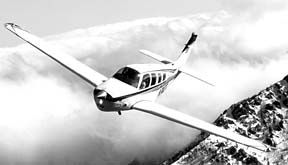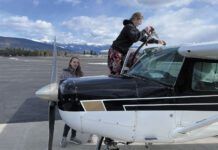Even if youre not one of those dotcom zillionaires, if you own a moderately expensive airplane, youve probably accumulated a nice tidy cache of wealth youd like to retain for your retirement years.
Owning an airplane, however, puts that wealth at risk. One of the biggest problems to face aircraft owners in recent years is the lack of higher limits of liability coverage beyond the run-of-the-mill million bucks, a sum thats chump change by modern insurance standards.
This is an expensive problem for pilots transitioning into bigger airplanes, but it plagues everyone who needs significant limits of liability, including people who have owned the same airplane for years.
Why It Happened
A number of factors brought this about. While accident rates have remained steady, the size of jury awards and settlements for injury in aircraft accidents has grown dramatically. In many cases, the manufacturer is no longer involved due to the General Aviation Revitalization Act, which provides relief for manufacturers of many older airplanes.
In the face of the judicial onslaught, insurers have increased premiums for the higher limits, reduced or eliminated their availability and increased training requirements.
Another problem facing underwriters is that rates in almost all areas have been low for the past several years. As a result, most have not made profits, and their shareholders and reinsurers are demanding higher returns on investment. All of this comes during what we we’ll surely look upon as the second Golden Age of general aviation. People are buying airplanes faster than manufacturers can build them. As a result, its not at all uncommon to find people flying airplanes that cost more than their limits of liability.
The $100 million man who can only buy $1 million of coverage is a Powerball Jackpot waiting to land on your house. And you don’t even have to buy a ticket. All this at a time when the economy is booming and capital and investment opportunities for insurers are plentiful. If the stock market corrects, we should be very, very scared.
New Solution
Youve surely heard this before, but now there’s a solution for many owners. A small group of aviation insurance professionals has put together a new program known as Menger Underwriting Service, LLC, which will provide excess liability coverage for aircraft owners.
This program, which has been in the works for more than a year, was put together by two experienced insurance professional. Tom Bradshaw, of Halton Hall and Associates of Fort Worth, Texas, has been an underwriter and broker for more than 30 years, and has extensive experience with overseas insurers and reinsurers. Ray Hall is the former CEO of AVEMCO Insurance and is the president of Menger Underwriting Service, LLC., which specializes in rating and reinsurance for aviation insurers.
During his years at AVEMCO, Hall developed some of the first computerized rating models used in the business and also built up extensive contacts among reinsurers, particularly in continental Europe. The impetus for the Menger excess program, and much of its initial start-up costs, came from John Allen of Falcon Insurance. Falcon was looking for higher limits for its Mooney, Beech, Piper and Cessna owners programs.
If you own a fixed-wing airplane and have limits of at least $1 million without passenger sub limits, this new program will probably allow you to purchase as much as $6 million of excess liability coverage, for total protection of $7 million or more. Helicopter owners will need a threshold of $2 million to qualify. By design, the coverage is not inexpensive, however. Hall and Bradshaw are trying to build a book of business which will be profitable for the insurer and hence sustainable.
Coverage is written through Clarendon National Insurance, a U.S. company with an A.M. Best rating of A, and the program is fully backed by three of the premier European aviation reinsurers.
The policy is written on a following form basis, which means that it incorporates most all of the requirements and conditions of the existing aircraft policy, known as the underlying insurance.
The new product is now available in 18 states, and approval in the rest is expected within the next 45 days or so. It is-or will be- available through Falcon, Halton Hall and most other aviation insurance specialists.
Web Based
The Menger program is designed to be easily accessible to brokers and is entirely Web and e-mail based. It relies heavily on the underwriting that was done by the underlying insurer, which is a common practice among excess carriers.
The rates are generated according to a formula and are based on hard government accident frequency and load factors and slightly softer estimates of probable maximum loss values.
The rating engine built into the rate calculator looks primarily at the number of seats in the aircraft, amount of underlying coverage, total limit of liability, and its intended use. The quote and application are done on the Website, and the only paper created is your policy. Turnaround time now is about five days and this will probably increase as the number of brokers using it increases, and then decrease as the minor bugs are worked out.
Big Numbers, Big Company
According to Bradshaw, there are several reasons that this program will be able to do what the main street aviation underwriters have not been able to do successfully. Chief among them is the fact that no single aviation underwriter has enough clients who need big limits to make money selling them.
The majority of light aircraft owners still feel that $1 million or less of liability coverage is adequate protection. For most underwriters, the cost of purchasing the higher amounts of reinsurance needed to support big limits for the small number of their clients who want them is such that they literally cannot charge enough, so most would rather not sell it at all.
The originators of the Menger program see it as filling a void rather than competing with existing underwriters; we suspect that most insurers will agree. In addition to providing excess liability through brokers, the program can also be used by underwriters as direct reinsurance if they decide to offer higher limits themselves.
There are certain categories of aircraft and aircraft use that the program surcharges, and some which it will not cover at all. Seaplanes and amphibians can be covered with an additional charge.
Among risks which cant be covered under the program are ultralights, gliders, balloons, foreign-based or operated airplanes, and helicopters used for flight instruction or rental. All of this is something of a work in progress, and the types of aircraft covered are apt to change over time. The program may also offer yet higher limits in the future.
There are some things to bear in mind when purchasing excess liability to increase your liability protection. Make certain that the name of both your underlying policy and your excess policy are identical. We also strongly recommend that you arrange to have the same expiration dates for both.
In order for the Menger program to provide protection on top of your aircraft policy, make sure that your broker has purchased the appropriate coverage add-ons for the excess as well. These include airport premises coverage, non-owned aircraft liability and others.
Above all, make certain that any changes that you make in your underlying policy are communicated to your excess carrier. The limit of liability that you carry on your underlying policy cannot be reduced without affecting your excess coverage or voiding it completely. For this reason, we also advise that you purchase excess from the same source as your underlying policy, if possible.
In general, buy as much limit from your primary carrier as you can and only then buy excess. The more underlying coverage you have, the less expensive your excess coverage will be.
We have used this program for a number of our customers during the two weeks that it has been available to us and, in our view, its quite we’ll designed, even if the Web site has some minor bugs.
We think that this program may succeed in the long term in taking care of a big problem. As Tom Bradshaw put it, We don’t want people selling their airplanes because they cant get the limits. That should not be a concern for a properly qualified pilot. Because of its A-rated security and well-designed logistics, perhaps for many, it wont be.
Jon Doolittle is an Aviation Consumer contributing editor and operates Sutton James Insurance in Hartford, Connecticut.





